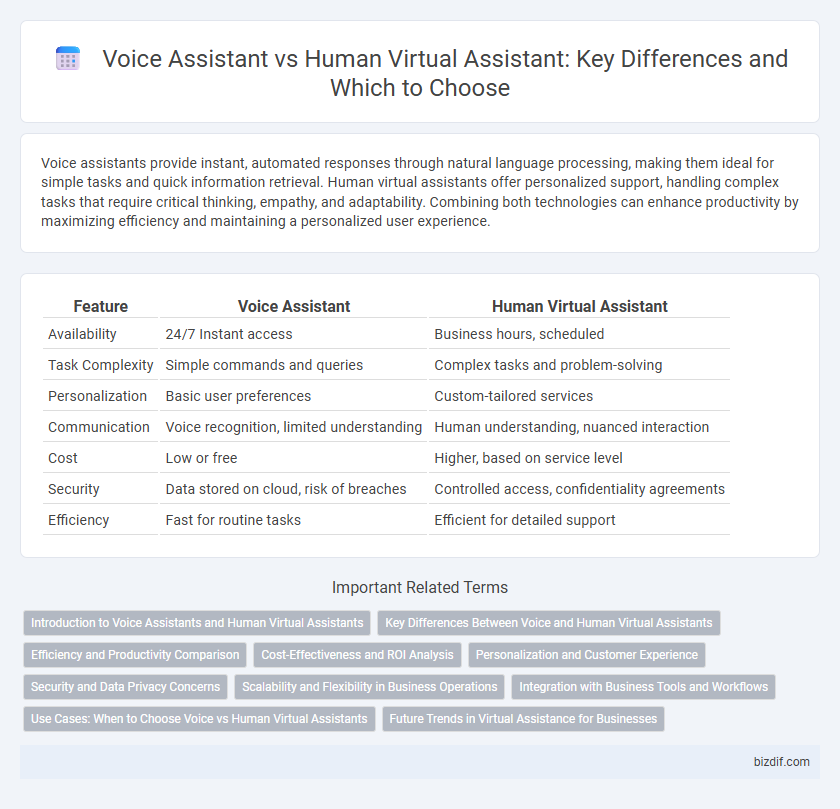Voice assistants provide instant, automated responses through natural language processing, making them ideal for simple tasks and quick information retrieval. Human virtual assistants offer personalized support, handling complex tasks that require critical thinking, empathy, and adaptability. Combining both technologies can enhance productivity by maximizing efficiency and maintaining a personalized user experience.
Table of Comparison
| Feature | Voice Assistant | Human Virtual Assistant |
|---|---|---|
| Availability | 24/7 Instant access | Business hours, scheduled |
| Task Complexity | Simple commands and queries | Complex tasks and problem-solving |
| Personalization | Basic user preferences | Custom-tailored services |
| Communication | Voice recognition, limited understanding | Human understanding, nuanced interaction |
| Cost | Low or free | Higher, based on service level |
| Security | Data stored on cloud, risk of breaches | Controlled access, confidentiality agreements |
| Efficiency | Fast for routine tasks | Efficient for detailed support |
Introduction to Voice Assistants and Human Virtual Assistants
Voice assistants utilize AI-driven speech recognition technology to perform tasks through voice commands, enabling hands-free interaction and immediate responses. Human virtual assistants provide personalized, context-aware support by managing complex tasks and adapting to nuanced communication, offering a level of empathy and discretion AI currently cannot match. Both solutions enhance productivity, with voice assistants excelling in automation and speed, while human assistants deliver tailored and flexible service.
Key Differences Between Voice and Human Virtual Assistants
Voice assistants rely on AI-driven speech recognition and natural language processing to perform tasks instantly, whereas human virtual assistants use contextual understanding and emotional intelligence to handle complex, nuanced requests. Voice assistants excel at quick information retrieval and automation but lack the adaptability and personalized touch that human assistants provide. Human virtual assistants offer superior problem-solving skills and can manage multi-layered communication, ensuring higher accuracy and tailored support.
Efficiency and Productivity Comparison
Voice assistants excel in handling repetitive tasks and quick information retrieval, boosting efficiency through instant responses and automation of routine activities. Human virtual assistants provide personalized support, adaptability, and complex problem-solving skills, enhancing productivity in tasks requiring critical thinking and emotional intelligence. Combining both optimizes workflow by leveraging the speed of voice assistants with the nuanced capabilities of human professionals.
Cost-Effectiveness and ROI Analysis
Voice assistants offer a cost-effective solution by automating routine tasks, reducing labor expenses, and providing 24/7 availability with minimal operational costs. Human virtual assistants, while more expensive, deliver personalized services and complex problem-solving skills that can lead to higher customer satisfaction and long-term client retention. Evaluating ROI reveals that businesses with high-volume, repetitive inquiries benefit from voice assistants, whereas personalized industries such as consulting gain more value from human virtual assistants.
Personalization and Customer Experience
Voice assistants leverage AI algorithms to deliver rapid, consistent responses but often lack the nuanced personalization that human virtual assistants provide. Human virtual assistants excel in understanding complex customer needs, adapting communication styles, and offering empathetic interactions, significantly enhancing customer experience. Personalized service from humans increases customer satisfaction and loyalty by addressing unique preferences and context-specific concerns.
Security and Data Privacy Concerns
Voice assistants often raise security and data privacy concerns due to constant microphone activation and susceptibility to hacking or unauthorized access. Human virtual assistants provide tailored security measures and discretion, ensuring sensitive information remains confidential through established trust and customized protocols. Businesses must weigh the balance between convenience and the risk of data breaches when choosing between voice and human virtual assistant solutions.
Scalability and Flexibility in Business Operations
Voice assistants enable scalable automation of routine tasks, handling multiple interactions simultaneously without requiring additional human resources, which significantly reduces operational costs. Human virtual assistants provide greater flexibility in managing complex, nuanced, or personalized tasks that require critical thinking, emotional intelligence, and adaptability to dynamic business needs. Combining voice assistants with human virtual assistants creates a hybrid approach that maximizes efficiency by leveraging automation's scalability and human expertise's flexibility in business operations.
Integration with Business Tools and Workflows
Voice assistants excel in seamless integration with popular business tools like CRM systems, project management platforms, and calendar applications through APIs, enabling automated scheduling, data retrieval, and task reminders. Human virtual assistants offer personalized adaptation to complex workflows, handling nuanced communication and customized problem-solving that AI may not fully interpret. Combining voice assistant automation with human oversight enhances operational efficiency by streamlining routine processes while ensuring flexibility for intricate business demands.
Use Cases: When to Choose Voice vs Human Virtual Assistants
Voice assistants excel in executing quick, routine tasks such as setting reminders, managing calendars, and providing hands-free information access, ideal for use cases requiring speed and simplicity. Human virtual assistants outperform in complex scenarios involving personalized customer service, nuanced problem-solving, and tasks requiring emotional intelligence or discretion. Choosing between voice and human virtual assistants depends on task complexity, the need for customization, and the level of interaction required.
Future Trends in Virtual Assistance for Businesses
Voice assistants powered by AI are rapidly evolving with natural language processing and machine learning, enabling more intuitive and context-aware interactions in business environments. Human virtual assistants continue to provide personalized, complex support that AI cannot yet fully replicate, especially in tasks requiring emotional intelligence and adaptability. Future trends indicate a hybrid approach where AI handles routine queries while human assistants focus on strategic and creative tasks, optimizing efficiency and customer satisfaction.
Voice assistant vs Human virtual assistant Infographic

 bizdif.com
bizdif.com